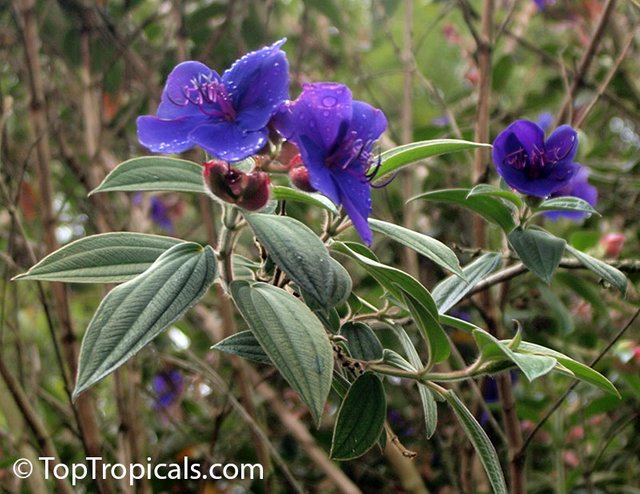RE: Beat the Blues with the Lasiandra
In my opinion, Tibouchina Alstonville is one of the easiest plants in the world to grow but I'm afraid I can't say the same about T. Jules.
We have tried to grow a couple at different times only to find they die after a year or two, which is quite disappointing.
T. Jules is one of those plants that seem to be totally intolerant of having the slightest hint of wet feet, so the drainage needs to be superb but that brings with it another problem.
During dry periods this plant still needs to be regularly watered because that extremely well drained soil dries out in no time at all.
I think that its low-growing habit means that it has a fairly shallow root system, which makes it vulnerable to environmental conditions.
T. Alstonville and T. Kathleen were joined later by another variety, Tibouchina Mutabilis Noelene, the flowers of which start off as pink then turn white as they age.
Some references suggest that this is another cultivar from the Dunstan stable while others are of the opinion it is a selection of the original mutabilis species.
There are a couple of newer versions of low-growing tibouchinas that I reckon are worth a second look. One is Tibouchina Jazzie and the other T. Groovy Baby, the latter bred by a Brisbane nurseryman. This one seems to be a much more reliable plant than the earlier T. Jules.
Regardless of who was responsible for their introduction to the gardening public, one thing is certain and that is they all have similar soil requirements.
It's no accident that the Dunstans grew their tibouchinas in the Alstonville region because there the soil is as good as it's ever going to get for that particular genus. It is a red, rich, volcanic soil that has a natural pH of just below 6.0, which is exactly what's needed for tibouchinas.
If the leaves of a tibouchina take on a burned margin, then the whole leaf turns yellow and drops, it is a sure sign the soil is not acidic enough. In most instances an application of sulphate of ammonia will suffice to lower the pH and, as a bonus, it will also promote leaf growth.
Organic fertilisers are becoming increasingly popular but they do tend to raise the pH more than chemical fertilisers so, if you are doing this around tibouchinas, it would be a good idea to sprinkle a little sulphur every second year.
Pruning is another misunderstood aspect of tibouchina culture. I have often come across gardeners who wonder why their tibouchinas have never flowered.
The first thing I would recommend is a liberal amount of superphosphate to supply phosphorus, the element necessary for flower initiation.
If the plant still doesn't flower, the next thing is to find out when it was pruned. If pruning in late summer or autumn, it is likely the wood on which the flowers were to be carried has been taken off. The rule of pruning is simple - get into it as soon as the last flower petal has fallen. If you delay it for too long, you progressively delay the flowering until you miss out on flowers altogether.
If you have a tibouchina that needs to be cut back but has never flowered, look around the neighbourhood to see when other trees finish flowering and go home and prune yours then.
Another plant that does well in slightly acid soil is the rather stunning Gordonia Axillaris, or "fried egg plant", so named because the large clump of bright golden stamens in the centre of the large white petals looks just like a fried egg.
This small tree is one that has suffered an identity crisis, thanks to the proclamations of botanists. It went from gordonia to franklinia, then to polyspora but, despite all these name changes, I think the marketplace still calls it gordonia.
If left to its own devices, it will grow to about 5m but it can be pruned back after flowering.
We have one in our garden that we planted about 20 years ago and, when it is covered in beautiful flowers, it really captures attention. And it does it all without any effort on our part - we haven't fertilised it, pruned it or treated it for pests or diseases for years.
